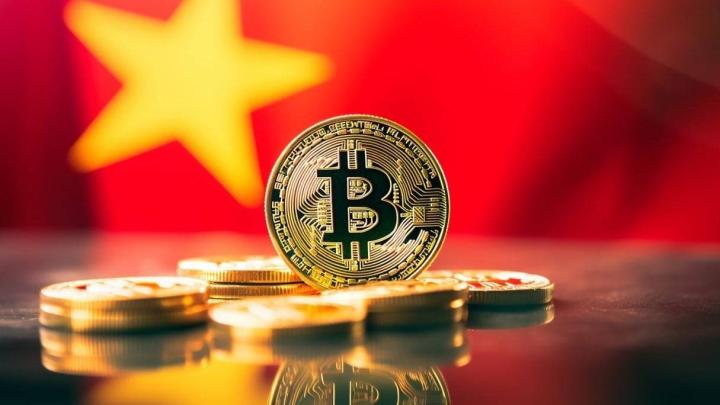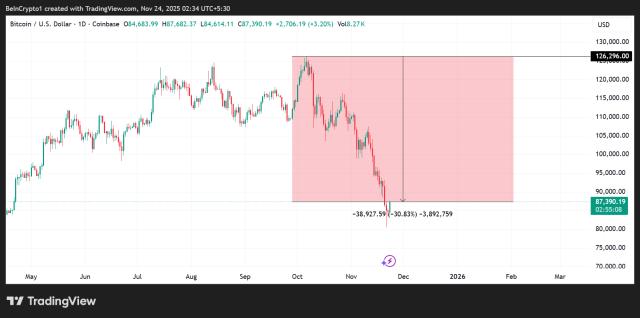Author: Ye Zhen, Wall Street Insights
As this quote on social media puts it: "We're all going long on Bitcoin, some of us just don't know it yet."

On November 24, Peter Tchir, a renowned strategist at Academy Securities, warned in his latest report that with the end of the "free money" era, this hidden leverage is backfiring on the market. The logic that companies could achieve several-fold increases in stock prices simply by announcing massive spending plans over the past two years has been broken, and this reversal is becoming the core driver of the recent decline in the Nasdaq index.
Recent market volatility has led to a decline of over 3% in the Nasdaq 100 index, while the more representative S&P 500 equal-weighted index fell by only 0.9%. This divergence highlights that the pain is primarily concentrated in the technology and high-growth sectors.
In particular, on October 10, Bitcoin experienced a sharp sell-off, plummeting from $122,000 to $105,000 during the US stock market close. This "inexplicable" collapse not only severely damaged crypto assets but also put direct liquidity pressure on a wide range of stock portfolios through the transmission chain of ETFs and related listed companies.

This phenomenon reveals a dangerous signal in the current market structure: cryptocurrencies, artificial intelligence infrastructure construction, and passive investment funds in US stocks have formed a highly interconnected chain. As passive investment surpasses active investment, hundreds of millions of dollars in retirement funds and hedging funds are effectively tied to the capital expenditure cycles of "digital asset reserve companies" like MicroStrategy and AI giants through ETFs such as QQQ.
Currently, investors have collectively turned their attention to the stability of the crypto market. Goldman Sachs trader Brian Garrett stated bluntly that many clients are viewing Bitcoin's performance as a barometer of future risk appetite, adding, "If Bitcoin's performance improves, the year-end stock market rebound may be on track."
The collapse of the "free money" mechanism
In his report, Peter Tchir attributes the recent market boom to the "free money" effect. "Free money" doesn't refer to central bank liquidity injections, but rather to a specific phenomenon in corporate capital operations: when a company announces an expenditure of X amount, yet its market capitalization increases by more than X, it essentially creates "free" shareholder wealth. This logic has primarily existed in two areas:
First, there's AI and data center construction. Previously, tech giants could simply promise to build more data centers (the logic of "once they're built, customers will come") to receive enthusiastic rewards from the stock market. However, now, simply announcing increased spending no longer translates into rising stock prices; the market is beginning to question the return on these massive investments. Once stock prices stop reflecting this, the next step for companies is likely to be cost-cutting, which will threaten overall economic momentum.
Secondly, there are cryptocurrencies and "Digital Asset Reserve Companies" (DATs). Companies like MSTR once enjoyed huge valuation premiums, raising funds to buy cryptocurrencies and driving their stock prices far above their cost of holding them. This positive cycle was once a major force supporting stock prices and the underlying crypto assets. However, this chain is now becoming increasingly difficult to operate, with the trading prices of many DATs gradually returning to and not closely reflecting their net asset value (NAV), meaning that the channel for "creating wealth out of thin air" is closing.
The "amplifier" effect of passive investing
The prevalence of passive investing has exacerbated this complexity. Peter Tchir points out that when large amounts of money “blindly” flow into the Nasdaq 100 (QQQ) index, 55 cents of every dollar goes to a few companies, including MSTR.
According to Bloomberg data, Vanguard, Blackrock, and State Street, as passive investment giants, are the top five holders of MSTR, with QQQ alone holding nearly $1 billion worth of MSTR shares. This holding structure means that if major index providers (such as MSCI) adjust their rules, it will trigger huge capital flows.

This index-based investing means that the volatility of crypto assets is no longer confined to the crypto. The market is currently highly focused on whether MSCI will include DATs in its stock indices (the decision is expected to be announced on January 15th). If MSCI decides to retain or include these companies, it will avoid forced selling and boost market expectations for the S&P 500 to subsequently include such companies; conversely, it could trigger mechanical selling by passive funds.
Soaring asset correlations and the backlash of the wealth effect
Bitcoin's market capitalization recently fell from a high of about $2.5 trillion to $1.85 trillion, and the market's "wealth effect" is facing headwinds due to the evaporation of $650 billion in wealth.
Peter Tchir observed that with the increasing popularity of spot ETFs, investors are no longer able to mentally separate crypto assets from their equity holdings. When investors see significant losses in crypto ETFs within their integrated equity accounts, panic is more easily spread throughout the entire portfolio, a stark contrast to the mindset of viewing assets in separate cold wallets in the past.
Even more surprisingly, some well-known investors have discovered that certain non-crypto assets they hold exhibit a remarkably high correlation with Bitcoin. This typically indicates that the same group of investors is facing liquidity pressures—when crypto assets plummet, they are forced to sell other highly liquid assets (such as US tech stocks) to raise cash. This cross-asset class sell-off has led to a simultaneous surge in both Nasdaq volatility and the VIX index.
Macroeconomic uncertainty and the Federal Reserve's dilemma
At the macro level, the Federal Reserve's policy path has become unpredictable once again. Market expectations for a December rate cut have fluctuated wildly from 34% to 63% in just one day. Despite mixed employment data and lingering inflation risks, the end of the "free money" era could lead to a slowdown in AI data center spending, thereby cooling the economy and providing the Fed with a reason to cut rates.
Meanwhile, the yield on 10-year US Treasury bonds, a safe-haven asset, has recently rebounded, while the rise in Japanese bond yields (the 30-year Japanese bond yield touched 3.3%) also warrants attention, as this could weaken the attractiveness of US Treasuries in the long term.
Peter Tchir concludes that the risks facing the economy are greater than ever before. If cryptocurrencies fail to stabilize, the resulting liquidity crunch and wealth loss will not only end the tech stock rally but could also drag down the overall pace of macroeconomic growth.
Everyone is holding their breath: Bitcoin's stabilization will be the first signal that the market has confirmed the end of the "painful trading."
Goldman Sachs trader Brian Garrett said, "Many of our clients believe that if Bitcoin trading conditions improve, a year-end rally could occur again."








